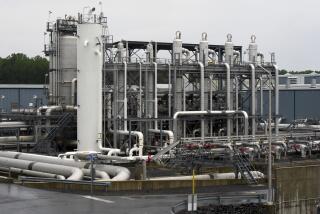Obama to open Alaska petroleum reserve to new drilling
- Share via
Reporting from Washington — President Obama will open Alaska’s national petroleum reserve to new drilling, as part of a broad plan aimed at blunting criticism that he is not doing enough to address rising energy prices.
The plan, unveiled in Obama’s weekly radio address Saturday, also would fast-track environmental assessment of petroleum exploration in some portions of the Atlantic and extend the leases of oil companies whose work in the Gulf of Mexico and the Arctic Ocean was interrupted by the drilling moratorium after last year’s BP oil spill.
The measures come as high gasoline prices and the resulting popular anger threaten the fragile economic recovery and, possibly, the president’s reelection chances in 2012. Congressional Republicans and some Democrats have been clamoring for increased domestic production in response to the rising prices, which economists say vary with global demand.
Obama also took on rising anger over the record profits of energy companies and stood by his demand to end subsidies for oil and gas companies, a proposal discussed in the Senate this week, according to a transcript of the address released Friday by the White House.
“There was more detail here than I’ve seen him do in two years,” said Sen. Mark Begich (D-Alaska), who backs the steps to increase production. “They’ve got to deal with this on multiple fronts: You have to deal with price; you’ve got to produce more. You need an aggressive, comprehensive, long-term policy, and the president is trying to reach down that path now because he realizes the pressure is on.”
House Republican leaders dismissed the proposal as far too little to address the country’s urgent energy needs.
“The president is finally admitting what Republicans have known all along — that increasing the supply of American energy will help lower prices and create jobs,” Rep. Doc Hastings (R-Wash.), chairman of the House Natural Resources Committee, said in a written statement. “One weekend address announcing minor policy tinkering, while positive, does not erase the administration’s long job-destroying record of locking up America’s energy resources.”
Two senior administration officials said in a teleconference Friday that the plan was meant to signal the president’s willingness to listen to a range of ideas, regardless of partisan politics, to improve oil and gas production in an environmentally sound way.
Said one official: “We’re drawing on the best ideas from the Democratic and Republican side of the aisle and the best ideas from industry.”
Environmentalists were not mentioned as a source of ideas. But they and oil industry representatives voiced cautious optimism that the steps laid out could coax more domestic oil without surrendering environmental safeguards.
“I think the president is really trying to thread the needle by trying to make sure we do things safely and at the same time we aren’t dependent on foreign oil from unstable countries,” said Marilyn Heiman, director of the Pew Environment Group’s U.S. Arctic program. “That differentiates him from members of the House who want to reduce oversight and speed permits.”
Industry experts welcomed the increased access to some federal lands, an effort to streamline permitting in offshore Alaska and the lease extensions, but decried the end of subsidies. House Republicans appear unlikely to eliminate the subsidies, which industry officials argue are needed to keep companies from seeking less costly opportunities overseas.
“Some of the access pieces are positive, but they’re baby steps and steps that have a lot of details to be wrapped around them,” said Erik Milito, director of upstream operations at the American Petroleum Institute, an oil industry group. “It’s a bit of a mixed bag because the tax proposal remains, so it’s hard to see how this will lead to positive expansive oil production going forward.”
The United States consumes nearly 25% of the world’s daily crude oil output but is home to only 2% of its proven reserves, leading analysts to conclude that increased domestic output will not drive down prices substantially.
The plan will not require congressional approval. Obama will direct the Interior Department to hold annual oil and gas lease sales in the National Petroleum Reserve-Alaska, beginning later this year.
No drilling currently takes place in the reserve, a 23.5-million acre tract west of the oil fields in Prudhoe Bay that is home to millions of migratory birds and serves as subsistence hunting and fishing grounds to indigenous peoples. A senior administration official said development would bypass environmentally sensitive areas.
Cindy Shogan, executive director of the Alaska Wilderness League, said although she believed more production could occur in Alaska, the Arctic posed challenges of extreme weather and risks to critical habitat. “This is a very different place than anywhere else in the country and it requires more scrutiny and requires us to be more careful than we have been before,” Shogan said.
The proposal does not include exploration in the Arctic National Wildlife Refuge or along the Pacific Coast. Areas of the Atlantic that would be subject to fast-tracked environmental review extend from the coast of North Carolina to northern Florida.
More to Read
Sign up for Essential California
The most important California stories and recommendations in your inbox every morning.
You may occasionally receive promotional content from the Los Angeles Times.











